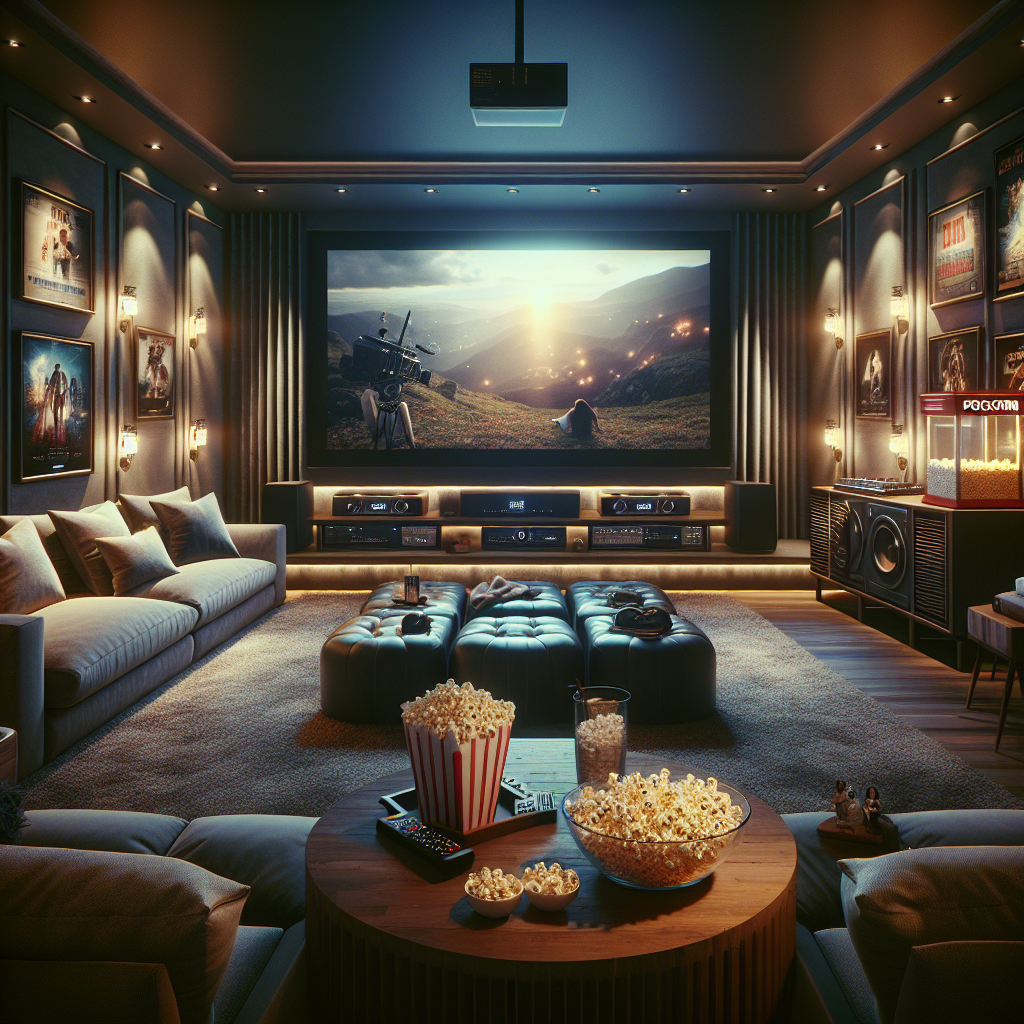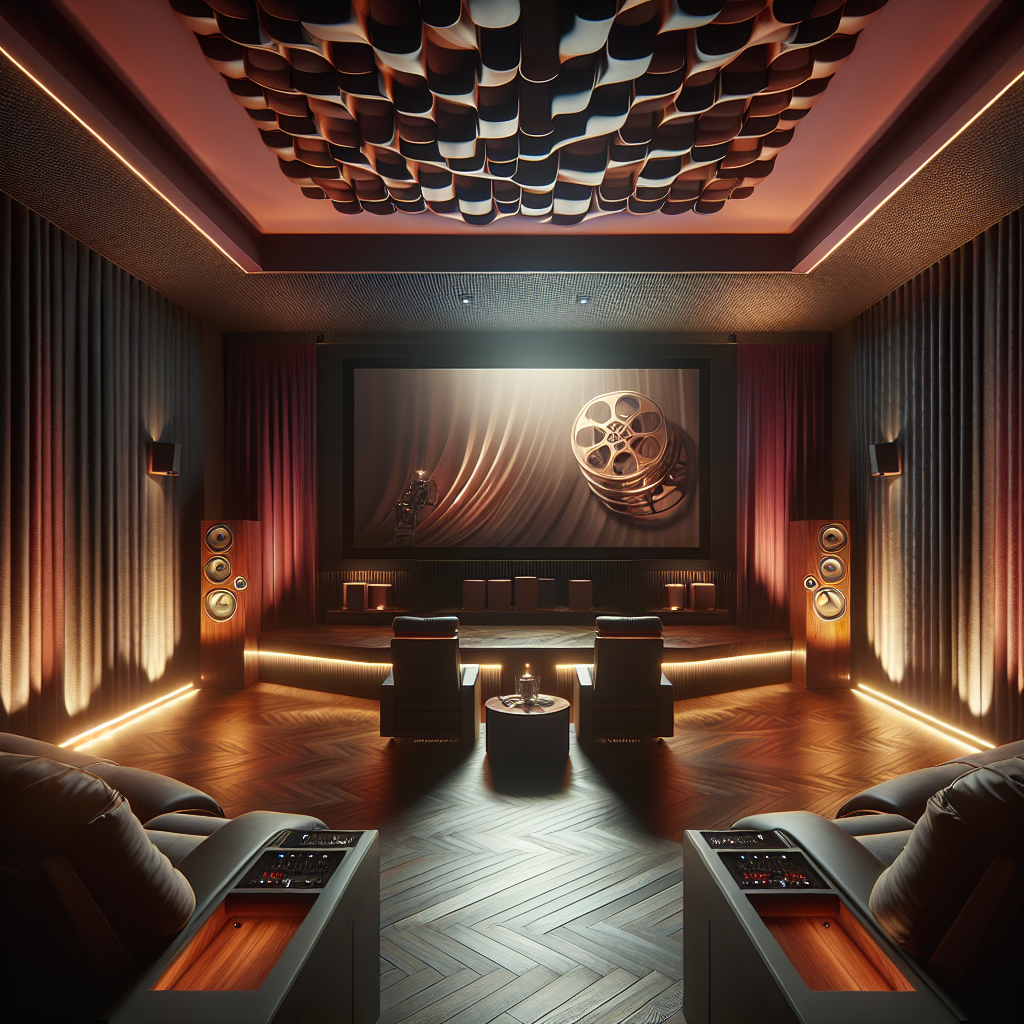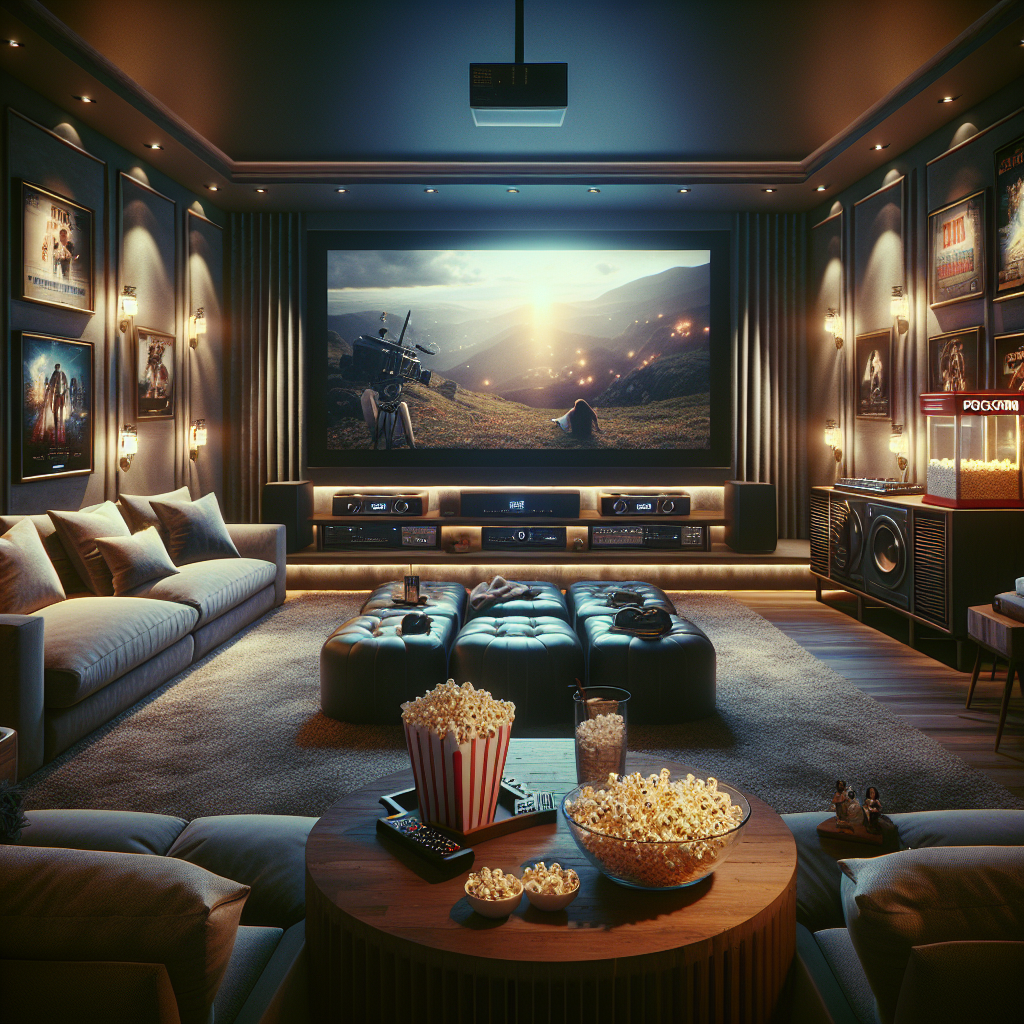Are you a movie enthusiast craving for the ultimate movie-watching experience in the comfort of your own home? Look no further! This article will provide you with an overview of the best home theater setups that will transport you straight into the heart of the magical world of cinema. From surround sound systems to projectors and cozy seating arrangements, you’re in for a treat as we explore the perfect ingredients to turn your living room into a mini movie theater. So grab your popcorn and prepare to be amazed!
Choosing the Right Room
Size and Shape
When setting up a home theater, one of the first considerations is the size and shape of the room. Ideally, you want a room that is large enough to accommodate your desired screen size and seating arrangement, while still providing enough space for sound to disperse properly. A rectangular room is generally recommended, as it helps with sound distribution and allows for optimal viewing angles.
Lighting and Windows
The amount of natural light and the presence of windows in your chosen room can greatly impact the quality of your home theater experience. It’s important to minimize light sources that can cause glare on your screen, such as windows or overhead lights. Consider using blackout curtains or blinds to block out any unwanted light and create a true theater environment.
Acoustics
Acoustics play a crucial role in the overall audio experience in your home theater. Hard surfaces, such as bare walls and floors, can cause audio to bounce around, leading to echoes or a distorted sound. To improve acoustics, consider adding acoustic panels or sound-absorbing materials to the walls. Carpeting or rugs can also help dampen sound reflections. Creating a well-balanced acoustic environment will enhance the immersion and clarity of your home theater sound.
Selecting the Perfect Screen
Projection Screens
Projection screens are a popular choice for home theaters due to their ability to provide large, immersive viewing experiences. When selecting a projection screen, consider factors such as screen size, aspect ratio, gain, and material. The size of the screen should be determined based on the seating distance and the room dimensions. Additionally, the aspect ratio should match the content you plan to watch. Higher gain screens can help enhance brightness, while different materials can affect the quality of color reproduction and contrast.
Flat-panel TVs
Alternatively, flat-panel TVs offer a convenient and sleek option for home theaters. The advancements in display technology have led to the availability of high-resolution, large-sized TVs that can deliver stunning picture quality. When choosing a TV, consider factors such as screen size, resolution (such as 4K or 8K), HDR capabilities, and the ability to display deep blacks and vibrant colors. Mounting options, such as wall mounts or TV stands, should also be taken into consideration.

Picking the Right Projector
Resolution
Resolution is an essential factor to consider when selecting a projector for your home theater. Higher resolution projectors, such as 4K or even 8K, can provide incredibly detailed and crisp images. However, it’s important to note that the resolution should match your screen size and seating distance to ensure optimal viewing experience. If you have a smaller screen or a larger viewing distance, a lower resolution projector may still deliver satisfactory results.
Brightness
Brightness is another crucial aspect to consider when choosing a projector. The brightness of a projector is measured in lumens, and it determines how well the image will appear in various ambient light conditions. For a dedicated home theater room with controlled lighting, a lower lumen projector may be sufficient. However, if your theater room has windows or ambient light that cannot be fully controlled, a higher lumen projector will help maintain a visually engaging image.
Contrast Ratio
The contrast ratio of a projector determines the difference between the darkest and brightest portions of an image. A higher contrast ratio ensures deeper blacks and brighter highlights, resulting in a more immersive and realistic viewing experience. When selecting a projector, look for a high contrast ratio to enhance picture quality and detail. Additionally, projectors with dynamic contrast ratio features can further optimize the contrast levels based on the content being displayed.
Optimizing Audio
Surround Sound Systems
To truly replicate the immersive experience of a movie theater, a surround sound system is a must-have for your home theater. Surround sound systems consist of multiple speakers strategically placed around the room, creating an enveloping audio environment. A typical surround sound setup includes front left, front right, center, surround left, surround right, and a subwoofer for deep bass. Pay attention to speaker placement, as proper calibration and positioning can significantly enhance audio quality and accuracy.
Soundbars
If you’re looking for a more compact and streamlined audio solution, a soundbar is a great alternative to surround sound systems. Soundbars are long, thin speakers that can be placed underneath your TV or mounted on the wall. They often come with built-in amplifiers and multiple drivers to deliver a wide soundstage. Some soundbars even come with additional speakers or subwoofers to provide a virtual surround sound experience. While not as immersive as a full surround sound system, soundbars are a convenient option for smaller spaces or those seeking simplicity.
Wiring and Setup
Proper wiring and setup of your audio system are essential for achieving the best sound quality. Ensure that all speakers are correctly connected to the audio receiver or amplifier using high-quality speaker wire. Pay attention to wire lengths to avoid signal loss or interference. Additionally, consider using cable management solutions to keep cables organized and hidden, reducing visual clutter in your home theater. Proper calibration of speaker levels and audio settings is also crucial to achieve optimal balance and clarity in your audio system.

Seating and Comfort
Theater-style Seating
Comfortable seating is an important aspect of creating an enjoyable home theater experience. Consider investing in theater-style seating options, which typically consist of reclining chairs with cup holders or armrests. Some theater-style seats even come with additional features like built-in speakers, USB charging ports, or LED lighting. Look for seating options that provide ample support, cushioning, and adjustability to ensure a cozy and luxurious movie-watching experience.
Recliners and Sofa Beds
For a more versatile seating arrangement, recliners or sofa beds can be a great choice. Recliners allow you to kick back and relax, while sofa beds provide the option for additional seating or a comfortable sleeping surface. Look for recliners with built-in features such as cup holders, USB ports, or massage capabilities for added luxury. Sofa beds can be particularly useful if you have limited space, as they offer dual functionality and can accommodate extra guests.
Soundproofing
To create a truly immersive movie-watching experience, soundproofing your home theater can make a significant difference. Soundproofing materials, such as acoustic panels, bass traps, or soundproof curtains, can help reduce external noises from entering the room and prevent sound leakage to other areas of your home. Additionally, consider using thick carpets or rugs to absorb floor vibrations and minimize sound reflection.
Lighting and Ambiance
Dimmable Lights
Proper lighting control is crucial in a home theater to enhance the viewing experience and create the right ambiance. Dimmable lights allow you to adjust the brightness according to your preferences and the content being watched. Consider installing dimmable recessed lights or wall sconces that can be controlled remotely or through a smart home system. Dimming the lights during the movie can reduce eye strain and help maintain focus on the screen.
LED Strip Lighting
LED strip lighting can add a touch of ambiance and enhance the visual appeal of your home theater. These flexible and easily installable strips can be placed behind the TV, along the floor, or behind seating platforms to provide indirect and customizable lighting. Some LED strip lighting options even come with color-changing capabilities, allowing you to create different moods for different viewing experiences. From vibrant neon to relaxing warm tones, LED strip lighting can transform your home theater into a visually stunning space.
Wall Sconces
Wall sconces not only provide functional lighting but also add a touch of elegance to your home theater. Strategically placed wall sconces can contribute to the overall ambiance of the room and create a true cinematic atmosphere. Consider installing sconces on the side walls or near seating areas to provide soft, indirect lighting that won’t cause glare on the screen. Opt for sconces with adjustable brightness or the ability to be controlled remotely for added convenience.
Remote Control and Automation
Universal Remotes
With multiple devices and components in your home theater setup, having a universal remote can simplify the control process. Universal remotes allow you to control all your audiovisual equipment, such as the projector, TV, audio receiver, and media players, from one single device. Look for a universal remote with programmable features and a user-friendly interface for easy operation. Some remotes even offer touch screens or voice control, making it even more convenient to navigate and control your home theater system.
Smart Home Integration
Smart home integration allows you to control your home theater using voice commands or through smart devices like smartphones or tablets. By connecting your home theater components to a smart home system, you can easily adjust audio and video settings, control lighting, or even schedule movie nights with just a few taps or voice commands. Ensure that your devices are compatible with popular smart home platforms such as Amazon Alexa, Google Assistant, or Apple HomeKit for seamless integration.
Voice Control
Voice control technology has become increasingly popular in home automation, and it has found its way into home theaters as well. With voice control, you can simply speak commands to control your audiovisual equipment, adjust volume, switch inputs, or even search for movies or TV shows. Many smart speakers or voice assistants such as Amazon Echo or Google Home can integrate with your home theater system and provide a hands-free and intuitive control experience.
Cables and Connections
HDMI Cables
HDMI cables are essential for transmitting high-quality audio and video signals between your source devices, such as Blu-ray players or gaming consoles, and your display. When choosing HDMI cables, look for ones that support the latest HDMI standards, such as HDMI 2.1, to ensure compatibility with high-resolution formats and features like HDR or Dolby Vision. Consider the length of the cables you need, and opt for durable and high-bandwidth cables for optimal performance.
Speaker Wire
When setting up your audio system, high-quality speaker wire is essential to maintain signal integrity and prevent signal loss. Look for speaker wire that is properly rated for your system’s power requirements and consider the length you need for proper speaker placement. Thicker gauge wires can help minimize resistance and ensure accurate audio reproduction. Additionally, consider using cable management solutions to keep speaker wires organized and hidden for a clean and professional-looking setup.
Network Connectivity
In the era of streaming services and online content, network connectivity is crucial for accessing a wide range of media. Ensure that your home theater setup is connected to a high-speed internet connection for smooth streaming, downloads, and firmware updates. If possible, use wired Ethernet connections for the most stable and reliable network performance. If a wired connection is not feasible, consider using wireless options such as Wi-Fi or powerline adapters to ensure consistent connectivity.
Calibrating the System
Video Calibration
Calibrating the video settings of your display is essential to ensure accurate colors, contrast, and brightness. Most modern TVs and projectors offer built-in calibration tools or presets, but for the best results, consider investing in professional calibration services or using calibration software and tools. By adjusting settings such as brightness, contrast, color temperature, and gamma, you can achieve a true-to-life and optimized picture quality that perfectly suits your viewing environment.
Audio Calibration
Properly calibrating the audio settings of your home theater system is crucial for achieving balanced and immersive sound. Audio calibration involves adjusting speaker levels, tonal balance, and equalization to optimize audio performance. Consider using a calibration microphone or hiring a professional to measure and optimize audio output. Calibration tools and software can help identify room acoustics and adjust audio settings automatically for the best possible audio experience.
Additional Accessories
Media Players
Adding a media player to your home theater setup allows you to access a variety of audiovisual content. Options such as Blu-ray players, streaming devices, or media streaming boxes offer convenient ways to enjoy your favorite movies, TV shows, or streaming services. When choosing a media player, consider factors such as compatibility with different formats, ease of use, and streaming capabilities. Look for devices that support high-resolution formats, HDR, Dolby Atmos, or other advanced audio and video features.
Gaming Consoles
For gaming enthusiasts, integrating a gaming console into your home theater setup can provide a truly immersive gaming experience. Consoles such as PlayStation or Xbox offer not only gaming capabilities but also the ability to stream movies and TV shows. Consider the gaming console’s graphics capabilities, processing power, and compatibility with the latest gaming technologies, such as ray tracing, high refresh rates, or virtual reality. Additionally, ensure that the gaming console is connected to your display with low latency for minimal lag and smooth gameplay.
Popcorn Machines
To complete the authentic movie theater experience, consider adding a popcorn machine to your home theater setup. Popcorn machines allow you to enjoy freshly made popcorn, just like you would at the cinema. Look for compact and easy-to-use models that fit well in your home theater space. Some popcorn machines even come with built-in warming features or butter dispensers for an extra touch of convenience and nostalgia.
In conclusion, setting up a home theater requires careful consideration of factors such as room size and shape, screen type, audio equipment, seating comfort, lighting, and control options. By evaluating each aspect and making informed choices, you can create a home theater that provides an immersive and cinematic experience right in the comfort of your own home. Whether you prefer a large projection screen or a high-resolution flat-panel TV, surround sound or a sleek soundbar, optimizing your home theater setup will allow you to enjoy your favorite movies, TV shows, and games like never before.

